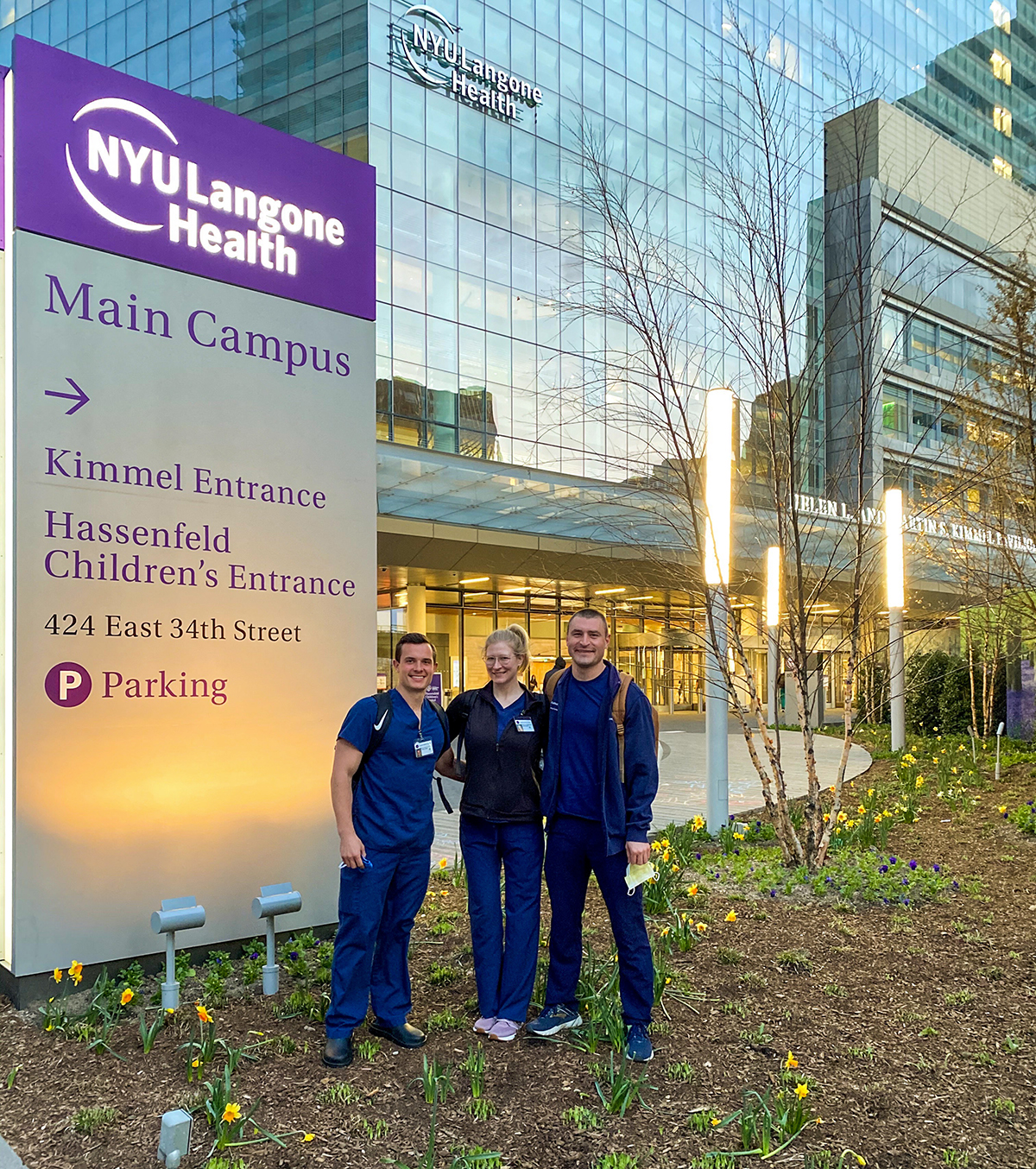Nursing hope: University of Akron anesthesia students go to NYC to care for COVID-19 patients
With people sick and dying, hospitals filling and hope dwindling, the message in news media was clear: Stay home.
But Katie Roberts heard a different message, like a clarion call: Rise, and go.
“I couldn’t quarantine in the comfort of my home thinking one person could die due to lack of staffing,” said Roberts, a registered nurse and graduate student in the Nurse Anesthesia Program at The University of Akron. “I knew I would regret not helping during this epidemic and New York City had the greatest need.”
So Roberts, along with Cody Ellis and Mike Hronec — also registered nurses and graduate students in UA’s Nurse Anesthesia Program — rushed off to New York City, where more than 15,200 confirmed deaths have occurred to date as a result of COVID-19.
For the past month, they have been working at NYU Langone Health in Manhattan in intensive care units designated for COVID-19 patients.
‘Duty as a nurse to help’
During their 48-hour weekly shifts, the UA students’ responsibilities include managing ventilators, supervising patients’ blood flow and taking on roles, such as administering breathing treatments, to decrease the number of people working in the unit and minimize exposure.

For the past month, Mike Hronec (left), Katie Roberts and Cody Ellis have been working at NYU Langone Health in Manhattan in intensive care units designated for COVID-19 patients.
“These patients are some of the sickest patients I have seen,” said Hronec. “They require a great amount of care because most of them are on ventilators to help them breathe. The nurses and staff in New York City needed all the help they could get in this trying time. I felt it was my duty as a nurse to help.”
The students described the city as “grim” and “very quiet,” the normally crowded streets now all but empty, with scattered pedestrians wearing masks for their safety and that of others.
According to Roberts, the “atmosphere in New York City is completely different than it is in Ohio,” where there have been more than 24,200 confirmed cases and more than 1,300 confirmed deaths to date.
“I have traveled to New York City before, and to see the city as empty as it is now, it feels almost post-apocalyptic,” Roberts continued.
Inside the hospitals, things are different.
“The hospitals are busy because of the amount of people contracting the disease,” said Hronec. “There are no visitors allowed in the hospital. Most of these patients have not seen their family in weeks because of this.”
Glimmers of hope
But there are bright moments too.
One day, Roberts was working at the medical center with a recovering male patient who was recently off sedation and completely oriented for the first time since his admission. The man had been in the hospital for 30 days and, because of a no-visitor policy, had not been able to see his family. So, Roberts asked the man for permission to FaceTime his wife at his bedside so they could see each other. After the call, and at the request of the man’s wife, Roberts called the man’s daughter, who had been unable to talk to him at all.
“When I called his daughter, she immediately burst into tears upon seeing his face,” recalled Roberts. “Listening to her speak to her father for the first time and watching his expression light up. He was crying with her and I was crying with them. I called my father after getting off shift. I will never take for granted something as simple and precious as a phone conversation with my family. I feel honored to have been a part of this interaction.”
The long, emotionally draining days spent caring for COVID-19 patients on the frontlines of the pandemic are demanding. The world is seeing instances and hearing stories about health care workers putting their own lives on hold to save the lives of complete strangers. Their efforts are not going unnoticed.
“Though work in New York City is tough, the city and the people here have been amazingly supportive,” said Ellis. “Every night at 7 p.m., the city erupts in cheers to celebrate those on the front lines. Many businesses are chipping in and helping fuel us through our days with little snacks or coffee. I couldn’t think of a better city to be in during such an uncertain time in our nation’s history.”
About UA’s Nurse Anesthesia Program
Students from UA’s Nurse Anesthesia Program — the largest such program in Ohio, with more than 35 clinical sites throughout the state — posted a 100% first-time pass rate on the Certified Registered Nurse Anesthetist (CRNA) exam in both 2018 and 2019, far surpassing the national average pass rate of 82-84% per year. Also, the program has had a 0% attrition rate over the last four years.
Media contact: Alex Knisely, 330-972-6477 or aknisely@uakron.edu.
